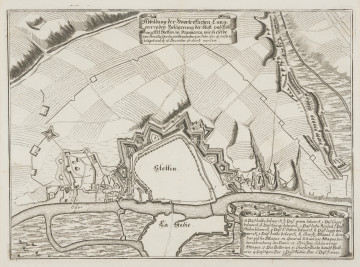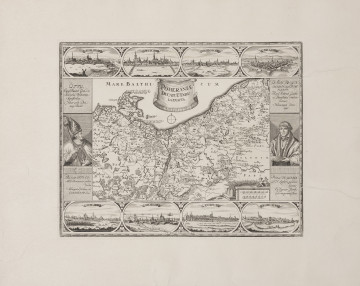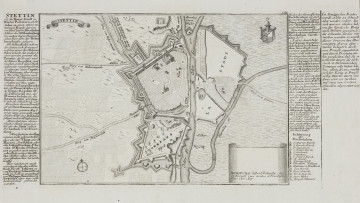
View of siege of Szczecin in 1677
1677 — 1682
National Museum in Szczecin
Part of the collection: Iconography of Szczecin in the 17th-19th centuries
Panoramas of Stettin (Szczecin), created after 1720, were propaganda oriented and showed new city fortifications altering the view of the city in a way that falsified reality. A tendency to simplify vedutas was typical of the Baroque period. These tendencies became evident in drawings by Friedrich Bernardt Werner (1690-1778), a Silesian engraver working for Nuremberg and Augsburg publishing houses. He made several hundred drawings of towns for them in total, which served as a basis for copperplate engravings. For the Augsburg publishing house of Martin Engelbrecht, he drew panoramas of Szczecin, which, despite errors and falsification of the actual shape of Prussian fortifications, were the first works recording urban changes after 1720. They were the basis for many engravings included in publications popularising Szczecin. Werner's works are a valuable source showing buildings that no longer exist. A drawing from the 1730s, updating the panorama of Szczecin with the Baroque helmet of St Mary's Church tower and exposing the southern fortifications, became the model for a copperplate engraving made by the Augsburg engraver Johann Georg Ringlin (1691-1761) from around 1735. It was one of 94 views of the city in the work Ansichten von Städten Europas und Alexandrien, also published by Engelbrecht. Ringlin's panorama appeared in two editions. The second edition, a print of which is in the collection of the National Museum in Szczecin, was decorated with an allegorical bordure consisting of war trophies and attributes of trade surrounding the coat of arms of Szczecin. The decoration was intended to symbolise the achievements of King Friedrich Wilhelm I of Prussia in strengthening the city economically and militarily. Although Ringlin modelled his work on Werner's drawing, he introduced changes emphasising Szczecin as a fortress and marked the presence of a harbour. This composition also became the model for later engravings.
Małgorzata Peszko
Author / creator
Dimensions
cały obiekt: height: 28,2 cm, width: 37,7 cm
Object type
chalcography (print)
Creation time / dating
Creation / finding place
Identification number
Location / status

1677 — 1682
National Museum in Szczecin

1720 — 1736
National Museum in Szczecin

1720 — 1740
National Museum in Szczecin
DISCOVER this TOPIC
Castle Museum in Łańcut
DISCOVER this PATH
Educational path